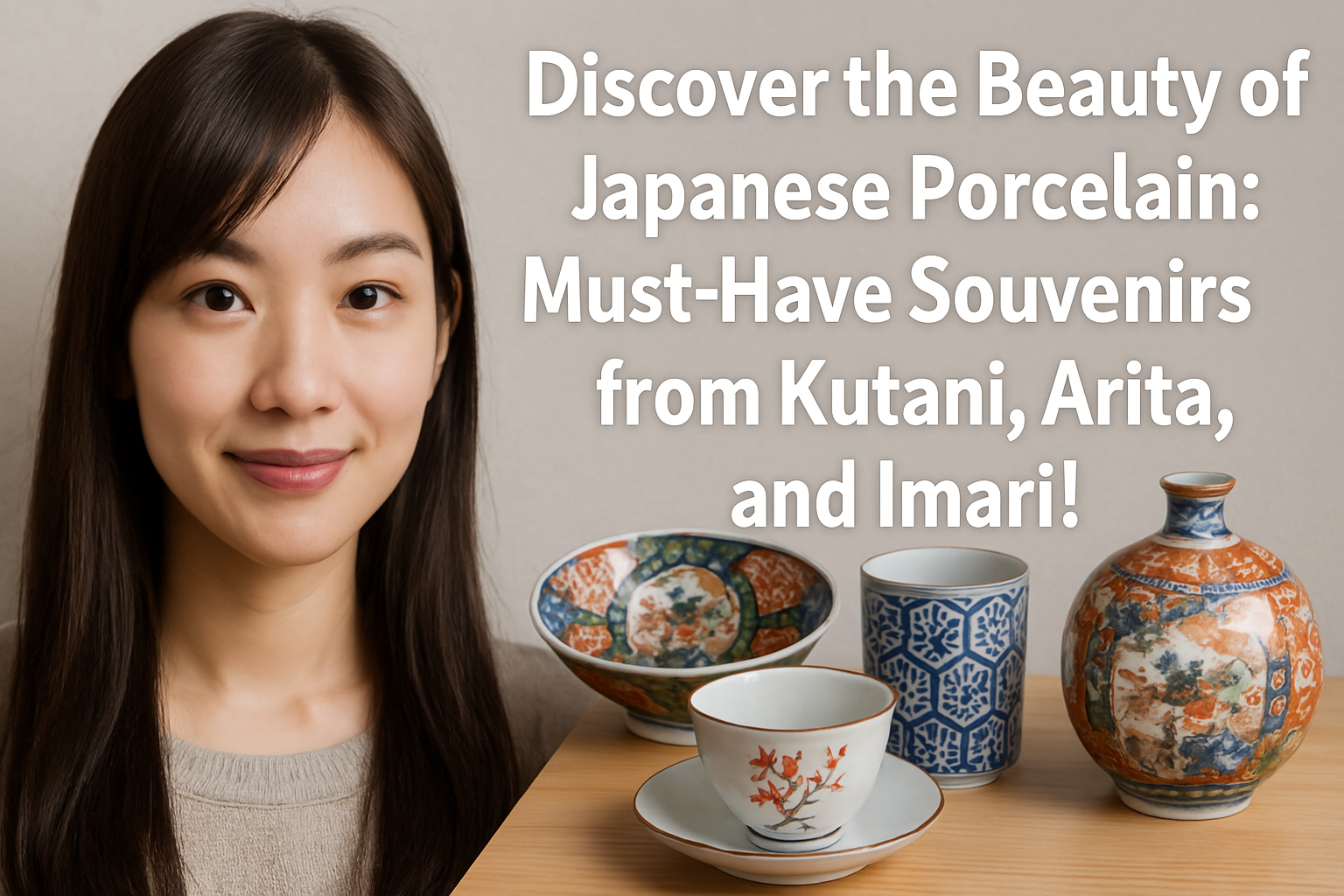- Discover the Beauty of Japanese Porcelain: Must-Have Souvenirs from Kutani, Arita, and Imari!
- Introduction: Why Japanese Porcelain Makes the Perfect Souvenir
- Top Japanese Porcelain Brands You Must Know
- Where to Buy Japanese Porcelain in Japan
- How to Choose the Perfect Piece of Porcelain for Your Collection
- Conclusion: Take a Piece of Japan Home with You
Discover the Beauty of Japanese Porcelain: Must-Have Souvenirs from Kutani, Arita, and Imari!
Introduction: Why Japanese Porcelain Makes the Perfect Souvenir
Picture this: you’re strolling through the picturesque streets of Japan, surrounded by centuries-old temples, vibrant markets, and the unmistakable charm of traditional culture. You’re in Japan, a land famous for its attention to detail, its respect for history, and its love for beauty in every form. And then, you spot it: a delicate piece of porcelain, gleaming softly in the sunlight, a perfect representation of the country’s elegance. Japanese porcelain is not just a souvenir; it’s a slice of Japan that you can take home with you.
Why does Japanese porcelain make such a great souvenir? It’s not just about buying something pretty—it’s about bringing home a piece of art, culture, and history. Whether you’re gifting it to a loved one or adding to your own collection, a porcelain piece from Japan tells a story. A story of craftsmanship, of tradition, and of Japan’s enduring love for beauty. Plus, let’s be honest: you’ll look pretty cool showing off your delicate porcelain bowl at home!
Top Japanese Porcelain Brands You Must Know
Now, if you’re going to buy Japanese porcelain, you’ll want to make sure you’re picking up something truly iconic. Japan is home to several famous porcelain brands, each with its own history, style, and distinct flair. Think of these porcelain brands like the rock stars of the pottery world, and you’re about to become their biggest fan!
1. Kutani Porcelain: A Colorful Tradition
First up, let’s talk about Kutani porcelain. If Japanese porcelain had a ‘pop star’, it would be Kutani. Known for its vibrant colors, intricate patterns, and sheer elegance, Kutani pieces are often eye-catching, making them stand out in any collection. I once took a tour of a Kutani workshop, and it felt like stepping into a kaleidoscope! The pottery is so colorful it almost feels like it’s telling you a lively story.
Kutani’s history dates back to the 17th century, with its origins in the Kanazawa region of Japan. The pieces are decorated with motifs that range from floral designs to scenic landscapes and even mythical creatures! The colors are rich and bold, which is why many collectors and tourists adore these pieces—they’re not just beautiful, they’re statement-makers.
History and Origins of Kutani Porcelain
Back in the Edo period (the 1600s), Kutani porcelain was born in the Ishikawa Prefecture, and it didn’t take long for it to become a symbol of high society. Imagine back then, being a noble, sipping tea from a Kutani teacup, feeling like royalty. The ceramics were originally handmade in the Kutani kiln, and their unique appeal comes from the way vibrant colors, especially greens, reds, and golds, are layered in intricate designs.
Why Kutani Is Loved Worldwide
What makes Kutani porcelain so special is its playful energy and unique design elements. Whether it’s a dinner plate featuring elaborate floral patterns or a cup adorned with intricate birds in flight, each piece is a work of art that can stand on its own. And let’s not forget, it’s practically impossible not to be drawn in by its bold, vibrant colors. It’s the perfect souvenir if you want something with a bit of ‘wow’ factor.
2. Arita Porcelain: A Legacy of Elegance
If Kutani porcelain is the pop star of Japanese pottery, Arita is definitely the timeless classic. Known for its delicate white porcelain and refined blue-and-white designs, Arita porcelain embodies elegance and tradition. Walking through Arita’s streets, you’ll be captivated by the endless array of porcelain wares that showcase the town’s rich heritage in pottery making. As a tour guide, I love seeing visitors’ faces light up when they see their first piece of Arita porcelain up close.
Originating from the town of Arita in Saga Prefecture, Arita porcelain has been crafted for over 400 years. It’s famous for its flawless white porcelain and the meticulous, hand-painted blue and red decorations. The designs often feature floral motifs, landscapes, or even mythical creatures like dragons—so there’s plenty of variety to choose from!
From the 17th Century to Modern Day
The story of Arita porcelain began in the early 1600s, when Korean potters helped establish porcelain production in Japan. The region became famous for its fine white clay and the techniques used to create translucent porcelain. Over the centuries, Arita porcelain has evolved, mixing traditional motifs with modern influences. Today, you’ll find Arita porcelain in everything from delicate teacups to intricate vases and even larger pieces like statues and tableware.
Distinctive Features of Arita Porcelain
What makes Arita porcelain truly unique is its translucent, smooth surface. This porcelain is typically thinner than many other types, which gives it an almost ethereal quality. The fine detail in the hand-painted designs, often blue and white or colorful reds, makes Arita porcelain a must-have for collectors. And let’s be honest—who wouldn’t want a piece of history that looks so refined and elegant on display at home?
3. Imari Porcelain: Classic Beauty with a Global Reputation
Finally, we have Imari porcelain, a classic that has been beloved not only in Japan but around the world. Imari porcelain is the sophisticated cousin of Arita porcelain, and it’s renowned for its bold designs and vivid colors. What’s remarkable about Imari is that it’s often hand-painted with luxurious gold and cobalt blue, making each piece look as if it’s ready to be displayed in a palace!
Imari porcelain dates back to the early 1600s and is one of Japan’s most famous porcelain types. It was originally produced in the Arita region, then shipped overseas through the port of Imari, hence the name. As trade routes expanded, Imari porcelain found its way into the hands of collectors across Europe, earning its global fame.
The Rich History of Imari Ware
Imari porcelain was first made in the Arita region in the early 1600s, but it got its name from the port of Imari, from which it was exported. As one of Japan’s first porcelain exports, it became a symbol of the country’s porcelain-making expertise. Imari’s popularity spread across the globe, especially in Europe, where it became highly prized by royalty and collectors alike. It wasn’t just a decorative piece—it was a status symbol.
How to Spot Authentic Imari Porcelain
Imari porcelain has a distinct look: typically adorned with vibrant reds, blues, and touches of gold. If you come across a piece with these colors, it’s a good indication it’s Imari. The designs often include floral motifs, phoenixes, and other mythical creatures, set against a backdrop of bold red or blue. When shopping for Imari porcelain, make sure to check for the signature blue underglaze mark, which helps confirm its authenticity. It’s like finding a treasure with its own secret signature!
Where to Buy Japanese Porcelain in Japan
Okay, you’re convinced—Japanese porcelain is a must-buy for your trip. But where do you actually get your hands on these beautiful pieces? Well, you’re in luck! Japan is filled with places where you can find authentic porcelain, from bustling city centers to the quaint towns where the porcelain traditions began.
Top Shops and Markets in Japan
When you’re looking to buy Japanese porcelain, you want to make sure you’re shopping in the right places. Head to areas like the town of Arita in Saga Prefecture or the Kutani region in Ishikawa Prefecture, where local artisans create some of the finest pieces. You’ll find stores and galleries showcasing beautifully crafted porcelain pieces, often with the opportunity to meet the makers themselves!
Exploring the Streets of Arita, Kutani, and Imari
Arita is like the Disneyland for porcelain lovers. The streets are lined with shops and galleries where artisans still create porcelain by hand, using techniques passed down through generations. Whether you’re exploring Kutani or Imari, you’ll feel like you’ve stepped back in time. You’ll often have the chance to see demonstrations and even try your hand at creating your own piece. It’s the ultimate experience for any porcelain enthusiast!
Online Shopping for Japanese Porcelain Souvenirs
Can’t make it to Arita or Kutani? No worries—many of these porcelain treasures can be found online! Websites like Japan’s famous department stores or specialty online porcelain shops allow you to browse the same high-quality pieces you’d find in person. Shopping online gives you the chance to find that perfect porcelain souvenir while sitting on your couch, sipping your matcha tea (trust me, it’s almost as good as the real thing!).
How to Choose the Perfect Piece of Porcelain for Your Collection
With so many beautiful options to choose from, how do you know which piece of Japanese porcelain to take home? Don’t worry—I’ve got you covered! Whether you’re buying for yourself or as a gift, there are a few things to consider when picking out the perfect piece.
Factors to Consider When Buying Japanese Porcelain
Think about what kind of style speaks to you. Are you drawn to the bold, colorful designs of Kutani, or the elegant, timeless beauty of Arita? If you’re looking for something traditional and serene, Arita might be the way to go. But if you want something that’s going to catch everyone’s eye at dinner parties, then Kutani’s colorful pieces are perfect.
Tips for Taking Care of Your Porcelain Souvenir
Once you’ve picked out your perfect piece, it’s time to think about how to take care of it! The good news is, Japanese porcelain is incredibly durable, but it does require a little TLC. Be gentle when cleaning, and never put your porcelain in the dishwasher (we’re talking about delicate artistry, after all!). With the right care, your porcelain piece can last for generations, telling the story of your trip to Japan for years to come.
Conclusion: Take a Piece of Japan Home with You
Japanese porcelain isn’t just a souvenir; it’s a beautiful piece of history, art, and craftsmanship that will remind you of Japan every time you look at it. Whether you’re picking up a vibrant Kutani piece, a classic Arita teacup, or a globally loved Imari bowl, you’re taking home more than just an object—you’re taking home a story. So, go ahead—pick up a piece of Japan’s porcelain heritage and start your own collection today!







コメント